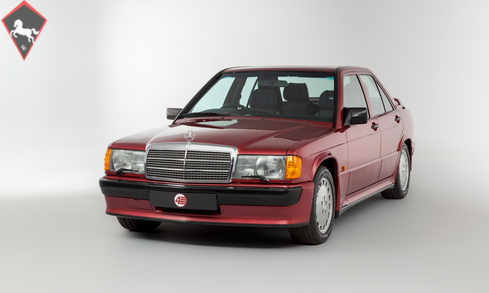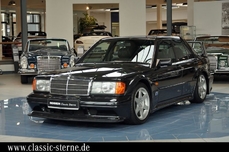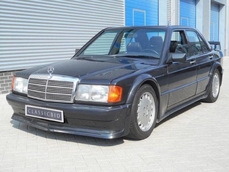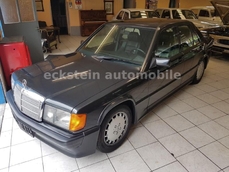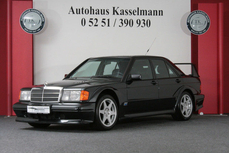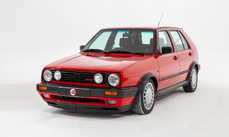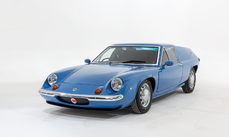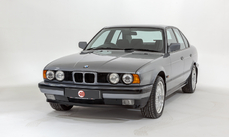Mercedes-Benz 190 2.5-16 2.5-16 Cosworth 1990
General description :
Model History
The Mercedes Benz 190 model name was first introduced in 1953 and has taken many different disguises until its final replacement in the form of the C series in 1993. The final incarnation of the 190 was the W201 chassis. £600 million was rumoured to have been spent developing the model, enough to have seriously damaged Mercedes-Benz reputation and financial position had the car been a failure. Luckily this was not the case and Mercedes went on to sell approximately 1.8 million units worldwide.
The introduction of the special edition 2.3-16v model in 1983 came from Mercedes-Benz's desire to re-enter motorsport with a direct factory team after their retirement following the tragic events at the 1955 Le Mans race. Enlisting the help of the British engineering firm Cosworth, Mercedes had plans to take the 190E to the rally circuit, however the project suddenly became unrealistic when Audi released the turbo charged, four-wheel drive Quattro, in effect beating the 190E before the race had even started! Mercedes not wanting to lose their financial investment in development ditched plans for the rally circuit and turned their attention to the German touring car championship.
The Cosworth engine was based on the 2.3-litre 8-valve already fitted to models in the range. Cosworth added an alloy head with twin overhead cams and 4 valves per cylinder boosting power to 185bhp and 174lb-ft. The car proved incredibly robust, with three cars only cosmetically altered completing a 50,000 km endurance test at the Nardo testing facility averaging 154.06mph and earning Mercedes three world records and nine international endurance records.
A larger 2.5-litre engine replaced the 2.3 in 1988. The 2.5 utilised a double valve timing chain to fix the problem of the single chains snapping on the 2.3. The increase in capacity took power to 204bhp in the non-catalyst car.
Both the 2.3 and 2.5 16v Cosworths featured a bodykit that reduced the drag coefficient to 0.32 one of the lowest figures for a four-door saloon at the time. The steering wheel was smaller and steering ratio quicker than other 190Es. The Getrag 5-speed manual ‘dogleg' box was standard, with the option of an automatic box along with a full leather interior. A limited slip differential was standard on the 2.3-16v, with the option of Mercedes ASD system that was standard fit on the 2.5-16v. ASD is an electronic system that hydraulically controls the amount of lock in the diff ranging from the standard 15% lock right up to 100%!
Equipment
Almandine Red Metallic paintwork, Half black leather/chequered cloth upholstery, 4-speed automatic transmission, 15-inch alloy wheels, Electric sunroof, Electric windows all round, electric passenger door mirror, Rear spoiler, Front air dam, Side skirts, Heated exterior mirrors, Heated washer nozzles, Leather steering wheel, Digital stopwatch, Rear armrest, Kenwood CD player with USB, Spare wheel, Spare keys, Mercedes fuel canister, Warning triangle, Original sales brochure, Original bill of sale.
Exterior
This cossetted 2.5-litre example presents beautifully in metallic Almandine Red. The paintwork boasts a lustrous shine all round having just been treated to a full detail and machine polish on arrival with us. The condition of the car is truly excellent throughout with no rust or blisters in any of the common W201 weak spots, the only negatives to report being a dusting of light frontal stone chips and two tiny marks on the driver’s side rear quarter. Having always been carefully stored away from the elements all the trims present in first-rate condition, and the underside is also remarkably clean. A best of breed example looking every bit the low mileage of just 68k.
VIEWINGS WELCOME BY APPOINTMENT ONLY /// ADDITIONAL PHOTOS AND VIDEOS AVAILABLE UPON REQUEST
Interior
A real treat for the enthusiast, the interior space is the finest we’ve seen of any 190E. The deeply bolstered sports seats are trimmed in the smart combination of black leather and chequered grey cloth, all in near-perfect condition with only the lightest of creasing to the driver’s side outer bolster. The rear seats are also immaculate and look as if they have been never sat in. The dashboard, centre console and wood trim are without any damage or marking, the switchgear still feels reassuringly solid to operate, and everything works exactly as it should. The carpets are spotless having always been protected by Mercedes overmats and, up above, the headlining is tight and mark-free. The boot area is also perfect and complete with the spare wheel, warning triangle, and Mercedes fuel canister. A well preserved and highly impressive interior, the only upgrade over standard being a Kenwood CD player with USB connectivity.
ENGINE & TRANSMISSION
Lifting the bonnet reveals an exceptionally clean and original engine bay. Often these cars suffer from cold start issues but with this example the 2.5-litre powerplant fires into life first turn of the key and ticks over smoothly. On the open road the auto ‘box changes smoothly with two program modes to suit the driver’s mood. The 16v engine pulls very well indeed, and inside the cabin there are no annoying squeaks or knocks to be heard. On arrival with us the car was fully inspected, MOT’d, and freshly serviced by our trusted classic car specialists, so she’s ready to be driven and enjoyed.
WHEELS, TYRES & BRAKES
Filling those boxy arches are the original 15-inch Mercedes alloy wheels, all in perfect condition having previously been refurbished to a very high standard. They are shod in a matching set of Avon tyres that have seen little more than 1k miles of use. On test the brakes feel capable and strong, stopping the car smoothly and in a straight line.
History File
This gleaming example was first registered in October 1990. Supplied new by Lancaster Mercedes-Benz of Hertford, the car remained under the same careful ownership until 2014. It was maintained religiously by Lancaster Mercedes until 51,527 miles before being retired to the South of France where it was tucked away in the first owner’s holiday home garage for a number of years. In early 2014 the car was brought out of dry storage and back to the UK; it was then fully recommissioned before finding a new home with its second owner.
The accompanying history file is complete with a raft of Mercedes and specialist invoices, old MOT certificates, original sales brochures, the original bill of sale from Lancaster Mercedes, and the service booklet which is stamped at the following mileages: 879 – 6,001 – 11,988 – 18,578 – 29,484 – 36,174 – 42,110 – 47,410 – 47,962 – 49,568 – 50,707 – 51,724 – 67,340 – 67,884 – 68,267 – and most recently at 68,510 in September 2022. The MOT is valid until September 2023 and the V5C shows 4 previous keepers (current since 2017).
http://www.4starclassics.com/for-sale/mercedes-190e-2-5-16-cosworth-for-sale/
1990 Mercedes-Benz 190 2.5-16 2.5-16 Cosworth is listed sold on ClassicDigest in Kingsley by 4 Star Classics for £29995.
Car Facts
Car type : Car Make : Mercedes-Benz Model : 190 2.5-16 Model Version : 2.5-16 Cosworth Engine size : 2.5 Model Year : 1990 Sub type : Pick up Location : Hampshire
Sold
Seller Information
Sold
People who viewed this Mercedes-Benz 190 2.5-16 also viewed similar Mercedes-Benz listed at ClassicDigest
Other cars listed for sale by this dealer
About Mercedes-Benz
In the annals of automotive history, the journey of Mercedes-Benz is a tale that unfolds with the ingenuity of its founding pioneers. In the year 1886, Karl Benz crafted the Benz Patent Motorwagen, a creation that would go down in history as the world's inaugural automobile. Unbeknownst to him, this moment marked the genesis of what would evolve into the most illustrious premium car manufacturer globally. The financial underpinning of this pioneering venture, interestingly, was provided by Karl Benz's wife, Bertha Benz, demonstrating a remarkable partnership that would set the tone for Mercedes-Benz's legacy.A parallel narrative emerged not far away, as Daimler-Motoren-Gesellschaft, founded by Gottlieb Daimler and Wilhelm Maybach, entered the scene. In 1901, they unveiled their automobile under the now-famous moniker "Mercedes," meaning "godsend" in Spanish. This name was bestowed upon the car at the behest of Emil Jellinek's daughter, the distributor for Daimler-Motoren-Gesellschaft. The wheels of innovation were set in motion.
Fast forward to 1926, a pivotal year that witnessed the merger of Daimler with Benz & Cie., culminating in the birth of Daimler-Benz. The amalgamation saw the adoption of "Mercedes-Benz" as the distinguished trademark for their automobiles, fusing the legacies of two visionary entities into one.
Contrary to perceptions of conservatism, the trajectory of Daimler-Benz unfolds as a chronicle of industry firsts. From the introduction of the honeycomb radiator to the float carburetor, and the pioneering implementation of four-wheel brakes in 1924, Daimler-Benz consistently pushed the boundaries of automotive innovation. The diesel-powered Mercedes-Benz 260 D in 1936 marked the inception of diesel engines in passenger cars. The iconic Mercedes-Benz 300SL Gullwing made history as the first car with direct fuel injection, albeit the Gutbrod's tiny 2-stroke engine can claim precedence.
Safety innovations became a hallmark, with Béla Barényi's patented safety cell design in the "Ponton"-models in 1951, featuring front and rear crumple zones. The W116 450SEL 6.9 saw the introduction of the Anti-Lock Brake system (ABS), another pioneering safety feature. From the first production airbags and beyond, the legacy of "firsts" continued to be etched into the fabric of Daimler-Benz.
Over its centennial journey, Mercedes-Benz has not merely produced cars but has sculpted automotive icons. The SSKL, 710 SSK Trossi Roadster, 770K Grosser, 540K Spezial Roadster, 300SL Gullwing, w100 600 Pullman, w111 280SE 3.5 Flachkühler, w113 230SL Pagoda, w109 300 SEL 6.3, and w201 2.3-16 Cosworth stand testament to the brand's commitment to engineering excellence.
The roaring Silver Arrows, or "Silberpfeile," including the W 25, W 125, W154, W165, and W196, created a legacy of dominance on the racetrack. These machines were not merely cars; they were expressions of precision, speed, and an indomitable spirit that left their competitors in the dust.
As Mercedes-Benz marches into the future, it does so not just as an automaker but as a custodian of a legacy, a torchbearer of innovation, and a beacon of automotive excellence. The road ahead is sure to witness the continued fusion of cutting-edge technology, timeless design, and an unwavering commitment to setting new standards in the world of automobiles.
One luminary figure who left an indelible mark was Béla Barényi, often heralded as the "father of passive safety" for his pioneering work in safety engineering. His patented safety cell design, featuring front and rear crumple zones, became a hallmark of Mercedes-Benz's commitment to occupant safety, setting new standards that reverberated throughout the automotive world.
Moving through the chronicles, the collaborative genius of Wilhelm Maybach, alongside Gottlieb Daimler, laid the foundation for Daimler-Motoren-Gesellschaft. Their innovations not only birthed the first Mercedes but established a culture of relentless pursuit of technological excellence that remains integral to Mercedes-Benz's DNA.
In the post-merger era of 1926, Ferdinand Porsche emerged as a prominent figure within Mercedes-Benz. His work on the Mercedes-Benz S-Type, a supercharged race car, garnered acclaim and set the stage for a legacy that extended far beyond the marque. Porsche's impact would later extend to his eponymous company, but his influence at Mercedes-Benz during those formative years was pivotal.
As the 20th century progressed, the legendary Rudolf Uhlenhaut emerged as a key figure. Uhlenhaut, an accomplished engineer and the driving force behind the iconic Silver Arrows, played a crucial role in Mercedes-Benz's dominance in motorsports. His engineering prowess and attention to detail were instrumental in creating some of the most formidable racing cars of the era.
In the latter half of the century, figures like Bruno Sacco, the head of design at Mercedes-Benz from 1975 to 1999, left an indelible imprint on the brand's aesthetic identity. Sacco's design philosophy, characterized by clean lines and timeless elegance, shaped iconic models like the W126 S-Class and the W201 190E, solidifying Mercedes-Benz's reputation for luxury and sophistication.
The narrative would be incomplete without acknowledging the contributions of engineers like Hans Scherenberg, whose leadership in the 1970s ushered in a new era of technological innovation at Mercedes-Benz. Scherenberg's tenure saw the development of groundbreaking technologies, including the Anti-Lock Brake system (ABS) and the introduction of airbags in production cars.
